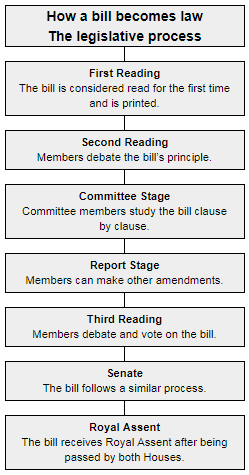Most every aspect of our lives has been touched on and considered in some way by our lawmakers. In Canada, our elected Members of Parliament are responsible for the creation, abolishment and reversion of existing laws. All our laws begin as a bill.
There are three types of bills: Government bills, Private Member’s bills, and Private bills. Government bills are introduced to Parliament on behalf of the government by a cabinet minister. Private member bills are introduced into Parliament by a private member. A private member is every Member of Parliament that is not a cabinet minister. Private bills are introduced into Parliament by individuals or corporations in the form of a petition. They confer a right on some person or group, or relieve them of a responsibility.
Rather watch a video explanation? Just press play.
Stages in How a Bill Becomes Law
Introduction and First Reading
At this stage the bill is distributed to the Members of Parliament. There is an announcement the bill is receiving it’s first reading and it is read. This is normally accompanied by a brief summary from the Member of Parliament introducing the bill.
Second Reading
During the second reading, the bill is debated. The debates are focused on the general principle of the bill. The details of the bill are not debated at this stage. Following the second reading, there is a vote to determine whether the bill should proceed to committee and which committee should review the bill.
Committee Stage
The committee reviewing the bill will discuss the merits of the bill, and the wording of the provisions. At this stage the committee may call witnesses and experts to present their views and answer questions asked by members. Once the entire bill has been considered and adopted with or without amendment, the committee votes on the bill as a whole. Once passed, the committee will report to Parliament with recommendations to make to the bill.
Report Stage
During this stage, Members of Parliament will further study the bill. After reviewing the bill, members may propose motions to amend certain provisions. To prevent the repetition of discussions that may have already occurred in the committee stage, the Speaker of the House selects and groups amendments for debate. At the conclusion of the deliberations at the report stage, a motion is held to approve the bill (with any amendments).
Third Reading
At the third reading the final draft of the bill is debated. Certain amendments to the bill are allowed during this phase. If passed by the House of Commons, the bill is reprinted incorporating any of the changes made during the third reading. The bill is then sent to the Senate where the process repeats from first reading through to the third reading.
Royal Assent
If the bill is passed by the Senate without any changes, it will be given royal assent. If the Senate makes changes to the bill, it must be sent back to the House of Commons for approval. Once given royal assent, the bill number changes to a chapter number and will be printed in the Annual Statues of Canada. The bill usual comes into force the day it receives royal assent unless otherwise indicated. Different sections of the bill may come into force at different times.
Our Parliament plays an important role in the criminal justice system. They decide what is illegal, the available sentences for any given offence, and criminal procedure. It’s important to have a lawyer who is not only up-to-date on the law, but who knows how the law is changing. If you, a friend or family member has been charged with a criminal offence, please feel free to contact me for a free initial consultation. I will be be glad to assist you.

